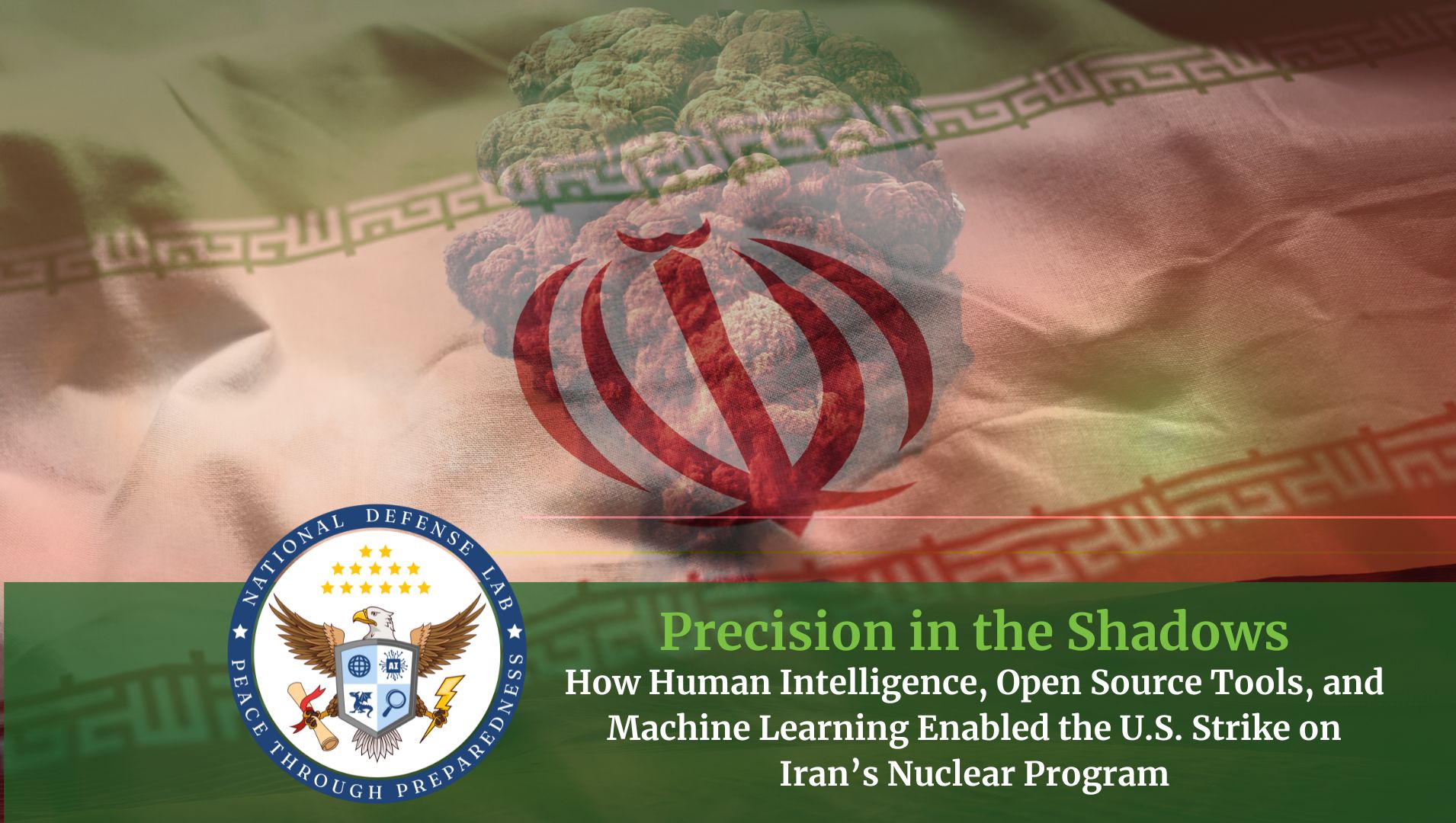Supercharge your defense operations with NDL solutions. Dive into a partnership that expands your team's cognitive reach. Ready to amplify your project's impact?
Precision in the Shadows: How Human Intelligence, Open Source Tools, and Machine Learning Enabled the U.S. Strike on Iran’s Nuclear Program

On June 22, 2025, the United States and its allies executed one of the most technically complex and geopolitically consequential military strikes in recent memory. Targeting deep underground components of Iran’s nuclear enrichment infrastructure, the operation unfolded with surgical precision, catching Iranian defense forces off guard and leaving regional observers stunned at both its speed and stealth. This was not a conventional airstrike. It was the product of years of painstaking intelligence work, next-generation surveillance, cyber warfare, and a newly matured hybrid model of human and machine intelligence working in lockstep.
Today we will take you behind the veil of that operation: exploring how U.S. intelligence fused classic spycraft (HUMINT), satellite surveillance (GEOINT), signals intercepts (SIGINT), public source monitoring (OSINT), and artificial intelligence (AI) into a seamless kill chain. It also offers a glimpse into the future of military operations, where AI-augmented planning, real-time sensor fusion, and predictive modeling reshape the battlefield.
A Perfectly Orchestrated Strike
Though officially unacknowledged by the U.S. Department of Defense, the June 2025 strike reportedly disabled multiple components of Iran’s nuclear weapons development program. The primary targets included a suspected underground centrifuge facility near Natanz, command and control bunkers tied to the IRGC Quds Force, and hardened air defense nodes near Isfahan.
Satellite thermal imagery released by private firms showed distinct heat blooms consistent with bunker-penetrating ordnance. Localized GPS disruption, power grid anomalies, and radar spoofing across western Iran suggested the presence of a cyber-electronic warfare component. Notably, no successful Iranian retaliation followed in the immediate aftermath, an outcome indicative of effective command disruption and possibly insider infiltration.
What set this operation apart was its precision, coordination, and the lack of observable pre-strike mobilization. By the time Iran realized what was happening, the munitions had already hit their targets and the platforms were gone.
The Intelligence Layer Cake: HUMINT, SIGINT, GEOINT, OSINT
Such precision does not begin with planes or missiles. It begins with knowledge. This strike relied on a multilayered intelligence backbone.
Human Intelligence (HUMINT): Deep-cover assets and recruited informants inside Iran likely played a crucial role in mapping the interior architecture of high-value facilities. HUMINT provided context AI cannot: trust networks, chain-of-command structures, and blind spots in personnel behavior.
Signals Intelligence (SIGINT): NSA and partner agencies probably intercepted encrypted military communications, power grid data, and internal coordination chatter. Tracking encrypted routing tables and command bursts offers insight into readiness cycles and reaction times.
Geospatial Intelligence (GEOINT): Satellite constellations and airborne ISR assets mapped facility layout, activity cycles, and heat signatures. High-resolution topography and multi-spectral imagery were used to model subterranean bunkers, ventilation systems, and likely points of structural failure.
Open Source Intelligence (OSINT): OSINT filled gaps with Iranian state media, academic publications, satellite imagery from commercial firms like Planet Labs, and social media tracking. Seemingly mundane posts about construction zones, traffic diversions, or funeral announcements of IRGC engineers helped confirm ground truth.
These disciplines did not work in isolation. They were fused. And the fusing agent was AI.
The AI and ML Revolution in Targeting
Artificial intelligence is no longer just scanning satellite images. In this operation, AI likely played roles in:
-
Target validation: Machine learning models scored and prioritized thousands of potential strike targets based on time-sensitivity, risk, and redundancy.
-
Anomaly detection: Pattern recognition tools flagged unusual movements, communications activity, and infrastructure fluctuations weeks in advance.
-
Simulation and prediction: AI-driven simulations tested various strike packages against Iranian air defense reactions, timing windows, and civilian risk matrices.
-
Language analysis: Natural language processing models scanned internal Persian-language communications, technical documents, and academic papers to identify covert program changes.
-
Data integration: AI systems ingested real-time satellite feeds, SIGINT packets, and human intelligence reports to offer unified situational awareness.
In short, AI did not replace analysts or commanders. It elevated them. It allowed analysts to detect weak signals in noisy data and allowed decision-makers to plan with foresight that no human team alone could muster.
The Human Edge Still Matters
Despite all the AI integration, the mission’s success ultimately hinged on humans:
-
Cyber specialists tailoring attack scripts to specific Iranian SCADA vulnerabilities
-
Linguists and cultural analysts interpreting deception patterns
-
Deep-cover agents providing access codes, confirming facility occupancy, or disabling specific doors
-
Commanders choosing the exact moment to strike based on political, tactical, and weather variables
AI provided advantage. But human judgment provided the will and moral discernment.
Strategic Implications: Welcome to Hybrid Intelligence Warfare
This strike was not just a blow to Iran’s nuclear ambitions. It was a signal to adversaries and allies alike. America’s fusion of data, code, and human daring is operational and scalable.
It also underscores a new strategic reality:
-
Future adversaries will not just be outgunned. They will be out-modeled.
-
Intelligence will not be gathered. It will be predicted.
-
Deterrence will depend not on how much we know but how fast we can integrate, act, and vanish.
Conclusion: The Model of Knowing Is the Weapon
What happened in Iran in May 2025 was not just a tactical victory. It was a glimpse of where warfighting is headed.
-
Less about mass mobilization
-
More about invisible convergence
-
Less about boots on the ground
-
More about data in the cloud
The fusion of AI and human intelligence is not coming. It is here.
And the nations that master it will not just win battles. They will shape the future.
Listen and Watch the Deep Dive Podcast Episode 92 - Precision in the Shadows, How Human Intelligence, Open Source Tools, and Machine Learning Enabled the U.S. Strike on Iran’s Nuclear Program



